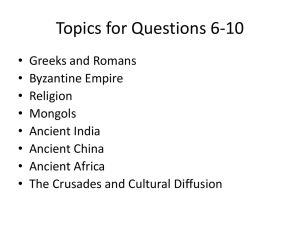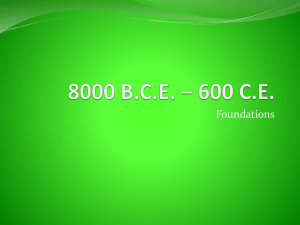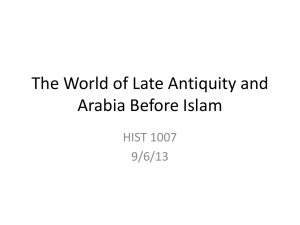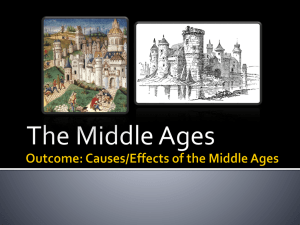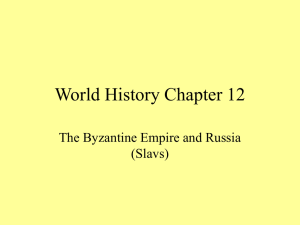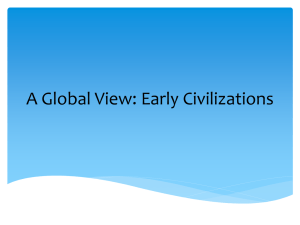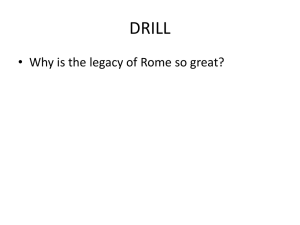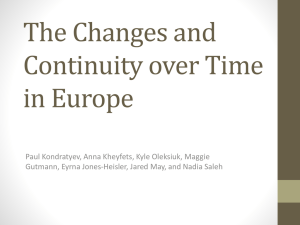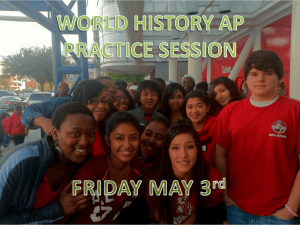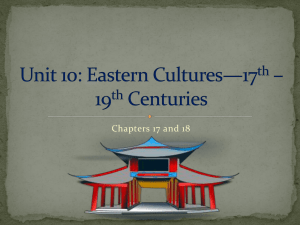Global 9 Review PowerPoint
advertisement
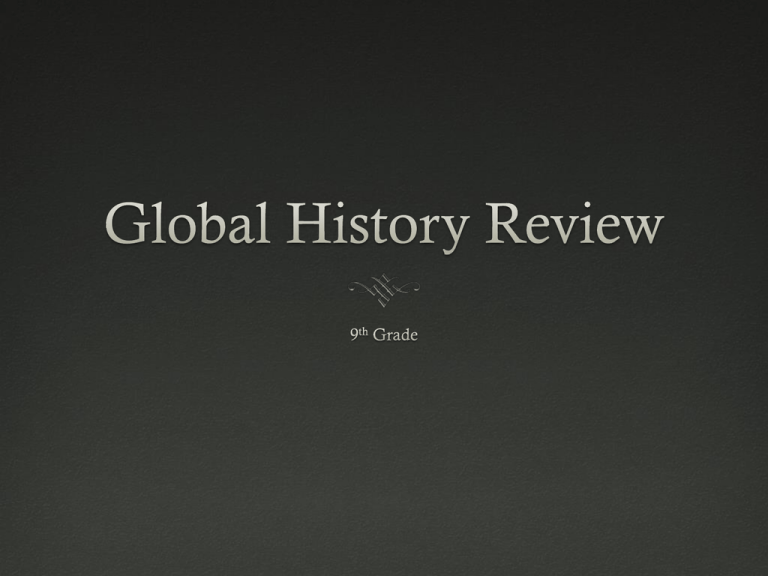
Intro to Geography Term Definition Latitude Lines of equal distance measured north & south of equator Longitude The curving distance east & west of the Prime Meridian; stretches from North Pole to South Pole Equator Zero degrees latitude, divides the Earth between north and south Prime Meridian Zero degrees longitude, divides the Earth between east and west Hemispheres Half of the Earth Absolute Location A point on the earth's surface expressed by a coordinate system such as latitude and longitude. Relative Location A location of a place in relation to another place (i.e. south or downhill). Geographic Features Geographic Feature Definition Effect Example Deserts Natural barrier; protection Limits trade, travel Sahara Desert Irregular Coastline Natural harbors Easier to invade Greece, Italy Island Protection Few natural resources, isolation Japan, Cuba, Madagascar Russia Lack of Warm Water Ports Monsoons Seasonal wind The rainy season accompanying the wet monsoon India Geographic Features Geographic Feature Definition Effect Example Mountain Protection from invaders Lack of cultural diffusion Andes Rainforests Resources- wood, medicine Limits interaction of people Amazon Regular Coastline Difficult to invade No natural harbors Africa River Valley Fertile soil Unpredictability of flooding Strategic Location Geographic or social position which plays a part in predetermined plan Tigris/Euphrates River Valley Fields of Study in Global History 1. Archeologist - F 2. Anthropologist - C 3. Sociologist - E 4. Economist - D 5. Geographer - A 6. Historians - B 7. Political Scientist - G Culture Culture: The shared beliefs, customs, practices, and social behavior of a particular nation or people. Cultural diffusion: The spreading of ideas through contact from one people to another. Characteristics of Culture: Cities, Organized Government, Religion, Job Specialization, Social Classes, Writing, Art/Architecture, Public Works In what ways can cultural diffusion occur: Trade or war. Religion Monotheism- belief in one God Polytheism- belief in many gods Religion Religion Book Location Basic Beliefs Animism None Africa All things in nature have a spirit Buddhism Tripitaka India Four Noble Truths; Eightfold path, Nirvana, Reincarnation Confucianism Analects China Five Relationships, Filial Piety Daoism/Taoism The Way of Virtue China People should live in harmony with nature, yin/yang (balance) Hinduism Upanishads India Karma, Dharma, Caste System, Reincarnation Shintoism None Japan All things in nature have a spirit Monotheistic Religions Judaism Torah/Talmud Middle East Ten Commandments Christianity Bible Europe Christ is Messiah, Ten Commandments Islam Qur’an, Koran Middle East Five Pillars, followers called Muslims First Civilizations The Neolithic Revolution allows for civilizations to form as people stopped hunting and gathering and began growing their own food. Early Civilization: Fertile soil Transportation Trade and communication Early Civilizations Egypt Pyramids Pharaohs Mummification Hieroglyphics North Africa Nile River Mesopotamia Fertile Crescent Cuneiform Ziggurats Hammurabi’s Code Tigris River Euphrates River India Grid pattern cities (Indus) Gupta Civilization- decimal system, plastic surgery Indus River Stupas China Mandate of Heaven Great Wall Civil Service Exams Huange He River Dynastic Cycle First Civilizations Vocabulary Pharaoh: an Egyptian god-king Ziggurat: a religious temple in Mesopotamia Hammurabi’s Code: codified system of laws, “eye for an eye” Mandate of Heaven: the divine right to rule that comes from God Civil Service Exam: a test that is taken by a person in order to get a government job First Civilizations DBQ 1. Controlled food supply; cultivation of edible plants; breeding of animals; became farmers and herdsmen 2. Location of river valleys 3. Taxing people too much; stops protecting people; infrastructure decays; treats people unfairly 4. Brings peace; rebuilds infrastructure; gives land to peasants; protects people 5. Pioneered use of herbs to treat illness; set bones; plastic surgery; vaccinating against smallpox 6. Vaccination of smallpox. Ancient Greece The Greeks developed many individual city-states because geography (mountains/waterways) isolated them from one another. The two most important city-states were Athens (golden-age) and Sparta (militaristic). One of the most important achievements of the Greeks is in the area of government. They developed a form of democracy. Alexander the Great spread a form of culture known as Hellenistic Culture. Famous philosophers include Socrates, Plato, and Aristotle. Ancient Greece: Vocabulary Practice Golden Age: a period of peace and prosperity Polis: another name for a Greek city-state Socratic Method: asking questions to develop an answer Hellenistic Culture: blending of Greek, Persian, Egyptian, and Indian culture Direct Democracy: each citizen take part in the day-today running of the government Ancient Greece: Venn Diagram • Limited democracy • Laws made by assembly • Only male citizens in assembly • Trade with other city-states • Education for boys • Women inferior Athens • Greek language • Mythological heroes • Olympic Games • Gods and religious beliefs Same • Monarchy with two kings • Military school • Trade/travel not allowed • Military training for all boys • Girls trained to be mother of soldiers • Women own property • Women obey men Sparta Ancient Greece DBQ 1. Democracy 2. Government favors the many instead of the few; advancement is open to everyone according to ability; every citizen has equal opportunity to serve the public; do not discriminate against the poor. 3. Columns. 4. Student answers may vary. Ancient Rome Rome lasted from 509 B.C. until 476 A.D. and its history is divided into two periods, Roman Republic and Empire. The Roman Republic was ruled by Consuls, patricians (senators), and plebeians. The Roman Empire begins when Julius Caesar becomes dictator. The Romans experienced a golden age during the Pax Romana in which they made many advancements. Their most important achievement was in the area of law. They developed the Laws of the Twelve Tables. During the Pax Romana the Romans made advancements in art, architecture, and engineering. They built roads, aqueducts, and the Coliseum. The collapse of the Roman Empire was not caused by a single event but rather a series of gradual events that took place over an extended period of time. Ancient Rome: Vocabulary Practice Pax Romana: 200 years of Roman peace and prosperity. Republic: political system where officials are chosen by the people Senate: an elected body Patricians: upper class citizens, land owners Plebeians: lower class citizens: farmers, merchants, artisans, and traders Laws of the Twelve Tables: laws that were written down for all to follow. Ancient Rome: Downfall Chart Military Causes •Invasion by barbarians •Mercenaries •Lack of loyalty •Army lacks training and discipline Economic Causes •High taxes •Unemployme nt •Inflation •Slave labor Political Causes •Ineffective leadership •Division of empire •Corrupt government Social Causes •Lack of patriotism •Welfare •Diseases •People become lazy Ancient Rome DBQ 1. People of same status equal before the law; accused is innocent until proven guilty; accused allowed to face accuser and defend against the charge; guilt must be established 2. Executives elected to terms; legislative branch each has a Senate; both have a Judicial branch; both have codified (written) laws; both have 3 branches of government Byzantine Empire The Byzantine Empire preserved the contributions of Ancient Greece and Ancient Rome for Western civilization (architecture, art, law). The Byzantine Empire was originally the Eastern portion of the Roman Empire. Constantinople became its capital and it thrived because of its location on major trade routes between Europe and Asia. Emperor Justinian developed a set of laws that became known as Justinian’s Code. It was a revision of the old Roman law system. Hagia Sophia was a Christian church built in Constantinople by Justinian. Is is still standing today but is a Muslim mosque. The Byzantine Empire influenced Russia through cultural cultural diffusion. This included the Eastern Orthodox Church, Cyrillic Alphabet, autocratic ruler, and art and architecture. The empire lasted until 1453 when they were conquered by the Ottoman Turks (Muslims). Byzantine Empire: Vocabulary Justinian’s Code: a set of laws developed by Justinian that included many Roman laws Autocratic Ruler: a single ruler with complete authority Cyrillic Alphabet: an alphabet developed by Eastern Orthodox monks used in Russia Islamic Empire, African Trading Kingdoms The Islamic Empire preserved Greek/Roman culture, made many achievements in the areas of math, science, medicine, architecture, literature, art, and they developed a prosperous economy. Some achievements of the Islamic Empire were calligraphy, study of algebra, astronomy, and medicine. These achievements eventually spread to Europe. African trading kingdoms developed in East and West Africa. They developed along trade routes. They made their money from the gold-salt trade. The main trading kingdoms in Africa were Mali, Ghana, and Songhai on the west coast while Nubia, Axum, and Kush were located on the east coast. Mansa Musa was a famous ruler of the kingdom of Mali. His greatest contribution is that he took a pilgrimage (hajj) to Mecca showing the importance of Islam while spreading culture. Islamic Empire, African Trading Kingdoms: Vocabulary Hajj: a religious trip to Mecca Calligraphy: artistic writing Gold-Salt Trade: the trade in gold and salt across northern Africa Bantu Migration: the Bantu migrated throughout Africa. It is one of the largest migrations in human history. This migration began in about 1000AD – 1800AD Islamic Empire, African Trading Kingdoms Islamic Empire 750AD African Trading Kingdoms Middle Ages After the fall of the Roman Empire, Europe was chaotic and lacked a central government. As a result, feudalism developed because people needed protection. Society was organized into a social structure. In this system lords gave lands to vassals/knights who in turn offered their service as soldiers in the lord’s military (land is exchanged for food and protection). Peasants and serfs were on the bottom of the social structure and worked the land. Manorialism is the economic system present during the Middle Ages. It was a self-sufficient community. The only stabilizing force during the Middle Ages was the Catholic Church. The Crusades were an attempt by the European Christians to re-conquer the Holy Land from the Jews and Muslims. The impact of the Crusades was that it increased trade with the Middle East, cities and towns grew, cultural diffusion, kings become more powerful and the church loses power. The plague killed millions of people throughout Europe and Asia. As a result the value of the individual ________________ and the church lost even more power. Middle Ages: Vocabulary Feudalism: land is exchanged for loyalty and military service Manorialism: economic system present during the Middle Ages; self-sufficient Chivalry: code of conduct that knights lived by Holy Land: land considered religiously significant to the Jews, Christians, and Muslims (Jerusalem) Middle Ages: DBQ 1. International trade served wealthy; carried on by Greeks, Jews, Muslims; local exchange was done by barter; ruled out need for gold coinage; Carolingians minted only silver coins; gold coins from Byzantine and Muslim empires used. 2. Not favorable to development of agriculture and commerce; selfsufficient; closed economy; lived in fear of world beyond manor; hoped to endure. 3. Religious motives; ashamed to fight amongst themselves; landhunger; general restlessness and taste for adventure; combining Christian duty with acquisition of land in southern climate. 4. Carried by fleas on black rats from the East Early China, Japan, Mongols, and Russia Like Europe in the Middle Ages, Japan was organized into a feudal society based on land holding. Samurai (like knights) were the warrior class and they followed the bushido code which is similar to chivalry. Japanese society was led by an emperor (figurehead). The real power was in the hands of the Shogun who controlled his Daimyo (lords). The Samurai were the warrior class with peasants, merchants, and artisans near the bottom. The Mongols, led by Genghis and Kublai Khan controlled a large empire in the Eurasian Steppe. Their strict rule allowed for cultural diffusion and safe trade along the Silk Road. They also influenced early Russia be demonstrating absolute government. Marco Polo is know for his travels throughout Mongol lands. His his journals are primary sources still used today for information pertaining to the Mongols. Ibn Battuta is also known for his travels throughout Asia. The Tang and the Song Dynasties were Golden Ages in China. Early China, Japan, Mongols, and Russia: Vocabulary Pax Mongolia: a period of peace and prosperity for the Mongols. Primary Source: a firsthand account of an event. Steppe: grasslands with rolling hills. Bushido Code: code of conduct that samurai follow. Golden Age: period of peace and prosperity; the period when a specified art, skill, or activity is at its peak Czar/Tsar: Russian absolute ruler Early China, Japan, Mongols, and Russia European Feudalism Japanese Feudalism King Emperor Lord Shogun Vassal Daimyo Knight Samurai Peasant/Serf Peasant Renaissance The Renaissance was a rebirth of classical Greek and Roman culture. It started in Italy during the 1300’s. The cities of Italy had great wealth from trade and manufacturing. As a result they spent their wealth on the arts and education. Humanism is the emphasis on the achievement of the individual instead of religious issues. During this period a questioning spirit emerged where people began to test traditional beliefs, mainly the Catholic Church. Famous Renaissance painters include Leonardo da Vinci, Michelangelo, and Raphael. Literary achievements include the works of Dante, Cervantes, Shakespeare, and Machiavelli. Renaissance: Vocabulary Golden Age: period of peace and prosperity; the period when a specified art, skill, or activity is at its peak Patron: a person that supports the arts Perspective: painting that suggests depth or distance Renaissance: Matching Activity Leonardo da Vinci: Mona Lisa, The Last Supper Michelangelo: Sistine Chapel, David, Pieta Raphael: The School of Athens Machiavelli: The Prince Shakespeare: Romeo and Juliet, Hamlet Cervantes: Don Quixote Dante: Divine Comedy Renaissance: DBQ 1. Praised man himself as creator; played down sinfulness and emphasized ability to think and act for self, produce works of art, and guide destiny of others; allowed to roam at will; seen as the ruler of nature; heightened awareness of self; intrigued with exploring their own personalities. 2. Studied the anatomy of human body; dissected and studied human corpses; interested in the structure and function of various parts of human body; his drawings reflect what he learned. Reformation The Protestant Reformation was a major turning point in history. It was a call by Martin Luther to reform the practices of the Catholic Church. Martin Luther was upset with Church corruption, including the practice of selling indulgences, and he nailed the 95 Theses to a church in Wittenberg, Germany. The Church wanted him to recant his ideas and he refused. He was excommunicated. Luther’s ideas spread rapidly by the invention of the moveable type printing press. Johan Gutenberg is credited with developing moveable type. As a result of the Protestant Reformation, there was no longer religious unity in Europe. The Catholic Church lost some of its power giving more power to monarchs. John Calvin was another reformation leader. He believed in predestination. The Counter or Catholic Reformation was the Church response to Luther. During this period the ended corruption and returned to traditional teachings. These reforms were made at the Council of Trent in 1545. Ignatius of Loyola started the Jesuits who emphasized spiritual and moral discipline and strict loyalty to the Catholic Church. Reformation: Vocabulary Indulgences: letters that could be purchased to have sins forgiven 95 Theses: Martin Luther’s 95 issues with the Catholic Church Excommunicate: to be banned from the Catholic Church Predestination: belief that certain people were chosen by God for Heaven; the divine foreordaining of all that will happen Reformation: Cryptogram Martin Luther was a German monk who started the Protestant Reformation. He posted his ninety-five theses on the church door because he was upset about the practice of the selling of indulgences. His action was a turning point in history because it increased the power of the monarchs in Europe and weakened the authority of the Catholic Church. Reformation: DBQ 1. Written on scrolls; bound at one edge; by monks who worked with pen and ink in a copying room. 2. An estimated ½ million books in circulation by 1500; acceleration of the Renaissance; Protestant movement, political and industrial revolutions; Guttenberg was bankrupted. Maya Mesoamerican Civilizations -built irrigation systems -city-states -pyramid shaped The Maya, Aztec, And Inca civilizationstemples -writing were located in Central and South system America. They are considered to be (hieroglyphics pre-Columbian civilizations. ) -calendar The Aztec and the Inca civilizations -number were defeated by the conquistadors. system with Although the civilizations were the use of advanced, their lack of military zero technology led to their defeat by the Europeans. Aztec Inca -Chinampas -strong central government -warrior society -practice human sacrifice -built Tenochtitlan -aqueducts -quipas/quipu -terrace farming -road system Mesoamerican Civilizations: Vocabulary Conquistadors: Spanish conquerors; ex: Cortez Chinampas: floating gardens Quipas: knotted strings used for record keeping Terrace farming: building steps in the side of a mountain or hill for farming Mesoamerican Civilizations: DBQ 1. Acknowledge the Christian church as the ruler and superior of the whole world; agree to let the Christian priests preach to you. 2. Spanish will forcefully enter into the country and make war against the natives; Spanish will take the wives and children and make slaves of them. 3. Overturned the idols and rolled them down the stairs; had the places cleaned of the blood; set up Christian images. Age of Exploration In the 1400’s Europeans began exploring the world as a result of the invention of the astrolabe and the caravel as well as improved mapmaking skills by cartographers. European’s began dominating the peoples of Africa, Asia, and the Americas. This is known as imperialism. The reason they dominated these countries was for God, golf, and glory. Some key explorers include: Prince Henry the Navigator, Ferdinand Magellan, Vasco da Gama, and Christopher Columbus. Mercantilism is the policy of a country to export (sell) more than they import (buy) to build wealth. The social structure of the Spanish controlled regions of Latin America included Peninsulares, Creoles, Mestizos, Mulattoes, and the Native Americans/slaves. A slave trade developed that included finished goods from Europe going to Africa. Slaves were traded from Africa to the Americas and raw materials being traded from the new world to Europe. This was known Triangular Trade. As a result of the Age of Exploration, goods, ideas, customs, and technologies were exchanged between the Eastern and Western Hemispheres for the first time. This is known as the Columbian Exchange
